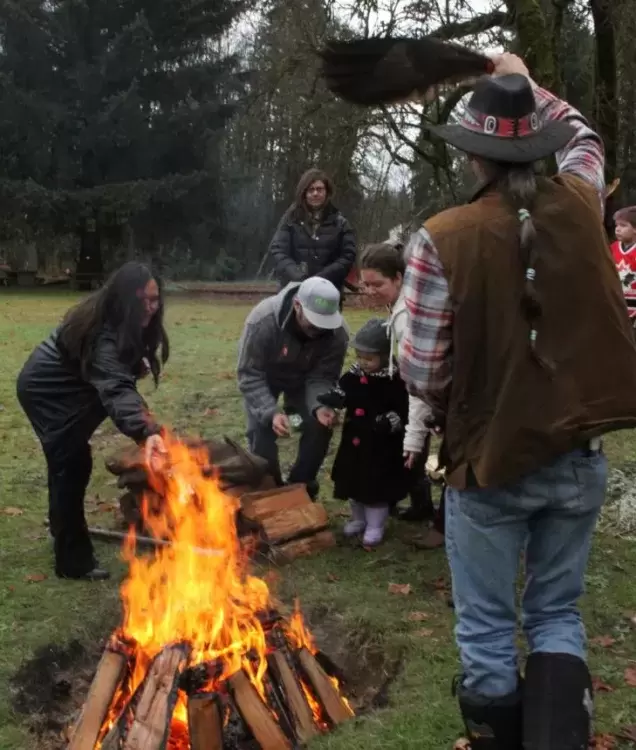One Nation. One Tribe. One Fire. That was the message of today’s demonstrations held across the country in solidarity with Attawapiskat Chief Theresa Spence, who is entering the third week of a hunger strike in Ottawa.
There are no boundaries on our territories today, said Aaron Watts of Tseshaht Nation. He was one of the organizers of a prayer ceremony held on the banks of the Somass River, a spot of great spirituality for the Tseshaht people, he said.
“Government hasn’t lifted an eyebrow,” said Watts of the federal response to Chief Spence’s hunger strike. Spence is one woman standing up for a nation, Watts explained. She had called on communities from coast to coast to coast to rally at 2 p.m. eastern Dec. 30 to provide an extra push of awareness of her goal to gather Prime Minister Stephen Harper and his government, the Queen’s representative, Governor General David Johnston, and First Nations leadership for a meeting to discuss the treaty relationship.
Watts said people were standing together in protest against government’s inaction. He said the prayers today were for those involved in the movement to help them remain strong, positive and safe. They were for Spence.
The prayers on the Somass began at 11 a.m. with about 60 people attending the one-hour event. Participants were offered cedar boughs and sage and invited to say a prayer and burn the medicine in a fire to send good energy and thoughts to the chief who is sacrificing herself for the people.
Chief Spence's hunger strike and the Idle No More movement that has seen demonstration after demonstration across the country protesting Bill C-45, came on the heels of a march by chiefs on Parliament Hill Dec. 4. A few chiefs went to the House of Commons to speak with government members voting to pass Bill C-45. There was a brief scuffle with security as the chiefs attempted to enter the House where the bill was being discussed.
Bill C-45 was a budget implementation bill (now law) that had buried within it the removal of protections to waterways across Canada, that changed the Indian Act, that changed the threshold to surrender reserve lands, all without consultation with First Nations.
Watts said he has been amazed by the response of the grassroots people to “Idle No More."
Keith Hunter told the people gathered on the Somass at Paper Mill Dam Park that the fire there was connected to the same fires burning across the country. Throughout the ceremony, Hunter would take up a cedar bough and offer a prayer before placing it on the fire. The flame would catch and crackle and burst brightly with energy and provide warmth to the group gathered around it.
After Elder Kathy Robinson said a prayer, her daughter Anne Robinson told the group her mother was praying for all of the children and youth who had been motivated to become a part of Idle No More. It was the young people who desired “to make things right and fair” after decades of government abuse and oppression.
“We refuse to go away, we refuse to die, and we refuse to change,” said Anne.
Judith Sayers of Hupacasath said Chief Spence had called pipe carriers to gather around her. Her tipi, that sits on Victoria Island in the shadow of Parliament Hill and the Supreme Court of Canada, is joined now by four others. Spence, a beautiful lady that has inspired so many to stand up for the waters, to stand up for First Nations rights, is growing weaker by the hour, said Sayers.
Brenda Sayers sang a prayer song in defence of First Nations rights, standing as a family, united with one cause, she said.
“Keep that fire that burns inside alive because it burns for all of us,” she said.
Dr. Simon Lucas spoke in his traditional language about the elders’ teachings.
“Life is enormous,” he said. “Hang on to life…don’t ever let life go.”
It is quite a sacrifice “that lady” (Spence) and others are making, Lucas said. From the teachings “we know exactly what she is giving up.”
Lucas said the spirit of women are “extremely strong” and Spence’s hunger strike is a sacrifice for others so they can speak to the rest of the world about the treatment of First Peoples by Harper’s Conservative federal government.
“We are doing this on behalf of the grandchildren,” he said, as the cry of an immature Bald Eagle pierced the quiet and flew past the gathering.
Participant Darlene Watts held a baby in her arms as she spoke. His name in the Tsimshian language means “determined one,” she shared. “The struggle is for this one,” Watts said.
She said Chief Spence is standing tall saying she is no longer going to be treated with disrespect, no longer will she be abused, damaged or used as a pawn… she is saying “enough is enough.”
“Harper should be ashamed of himself,” said Watts of what she sees as the Prime Minister’s goal, to assimilate First Nations and kill indigenous society.
“He wants us all to become white,” she said.
After a song was sung, four young women were asked to present offerings of cedar, sage, sweetgrass and dried salmon to feed the spirits. The girls brought the medicine to the fire with a prayer. Young women were chosen for this duty because they are the most pure, the most sacred, explained Hunter.
To close, the participants, who had been standing in a circle around the fire, joined Aaron Watts on one side facing the east for a final prayer.
An island-wide day of protest will occur on Jan. 12 with each nation choosing its own form of demonstration. The Tseshaht people are currently meeting to decide what their protest will look like. There has been talk of blocking Highway 4, which travels through Tseshaht territory. Details will be provided soon.







